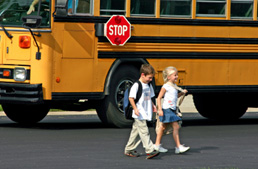Watch out for youngsters heading back to school
Posted in Accident & Injury on August 1, 2012
 The roadways in your area are about to get a little more crowded again in a few weeks as summer break draws to an end and schools will be back in session. With more distractions in traffic, it pays to slow down and pay attention. Drivers should take extra precautions at the beginning of the school year.
The roadways in your area are about to get a little more crowded again in a few weeks as summer break draws to an end and schools will be back in session. With more distractions in traffic, it pays to slow down and pay attention. Drivers should take extra precautions at the beginning of the school year.
Of course, anytime you are driving, you should eliminate any distractions so all your attention is on the road. But that is never more important than when you are in a school zone. Texting or using your cell phone can take your eyes off the road long enough to result in a tragic accident.
For parents who are sending your kids off to school on school buses, you can rest easy. School buses are one of the safest forms of transportation on the road today. In fact, according to the National Highway Traffic Safety Administration, riding a bus to school is 13 times safer than riding in a passenger vehicle and 10 times safer than walking to school.
The reality of school bus safety is that more children are hurt outside the bus than inside as passengers. Most of the children who lose their lives in bus-related crashes are pedestrians, 4 to 7 years old, who are hit by the bus or by motorists illegally passing a stopped school bus.
The National Safety Council has shared some helpful tips for motorists to help you and all the young ones heading back to school stay safe.
Sharing the road with school buses
- All 50 states have a law making it illegal to pass a school bus that is stopped to load or unload children.
- School buses use yellow flashing lights to alert motorists that they are preparing to stop to load or unload children. Red flashing lights and an extended stop sign arm signals to motorists that the bus is stopped and children are getting on or off the bus.
- All 50 states require that traffic in both directions stop on undivided roadways when students are entering or exiting a school bus.
- State laws vary on what is required on a divided roadway, but in all cases, traffic behind the school bus traveling in the same direction must stop.
- Stop far enough from the bus to allow children the necessary space to safely enter and exit the bus. The area 10 feet around a school bus is where children are in the most danger of being hit.
- Be alert. Children are unpredictable. Children walking to or from their bus are usually very comfortable with their surroundings, making them more likely to take risks, ignore hazards or fail to look both ways when crossing the street.
- Never pass a school bus on the right.
Sharing the road with child pedestrians
- Drivers should not block the crosswalk when stopped at a red light or waiting to make a turn. Blocking the crosswalk forces pedestrians to go around your vehicle and puts them in a dangerous situation.
- In a school zone when a warning flasher or flashers are blinking, you must stop to yield the right-of-way to a pedestrian crossing the roadway within a marked crosswalk or at an intersection with no marked crosswalk.
- Always stop when directed to do so by a school patrol sign, school patrol officer or designated crossing guard.
- Don’t honk your horn, rev your engine or do anything to rush or scare a pedestrian in front of your car, even if you have the legal right-of-way.
- Children are the least predictable pedestrians and the most difficult to see. Take extra care to watch for children, not only in school zones, but also in residential areas, playgrounds and parks.
Following these tips and paying extra attention when you are behind the wheel can help make going back to school a safe time for everyone.